
It all started with a simple craving. I was at home in my condo, looking out over the bustling streets of Thailand, when I noticed the familiar sight of the cheerful crepe vendor pulling up to her usual spot. Her cart was ready for the day, and my stomach quickly reminded me of its growing hunger. Without a second thought, I rushed down, eager for a delicious crepe stuffed with pork and chili. But by the time I made it outside, the vendor was already moving down the road, taking her cart with her. Panic set in. Do I chase after her or wait until she stops again? The polite side of me opted for the latter, and so I followed her, unsure of where this journey would take me.
As I trailed her down a road I rarely walked, the street started to feel unfamiliar, with only a few schools and a dead end in sight. But soon enough, she stopped, and to my surprise, I stumbled upon a hidden gem—an impromptu street food haven. It was a colorful display of vendors, each with their own delicious offerings. The new discovery left me both excited and oddly betrayed. For years, I had walked past my usual street food vendors, never realizing they had quietly relocated. I couldn’t help but feel like a kid discovering a whole new world.
A New Era of Street Food
My routine, which was already limited, was now thrown into disarray. The days before this discovery were predictable: breakfast at 10 am with a bowl of Tom Yum Kai (hot and sour chicken soup) and Kaprao Moo Grob (crispy pork belly with basil); then around 5 pm, I’d enjoy Som Tam (papaya salad) and grilled pork neck. But now, I had to contend with the temptation of snacking around 3 pm. Should I skip breakfast to make room for an afternoon bite? Or perhaps add a third meal to my day? It was all a bit overwhelming, and the thought of doubling my food intake felt like a troublesome decision.
Street Food for a New Generation
As I stood in the middle of the vibrant street food scene, surrounded by laughing children devouring chocolate lava buns, it became clear that this wasn’t the street food I remembered. The snacks in front of me were distinctly international: Gyoza (Japanese dumplings), Takoyaki (Japanese squid balls), Tornado fries, Bubble Tea (Taiwanese), and even the Chinese-inspired chocolate lava Pao. Gone were the days of traditional Thai street food; this new generation of street food seemed to be shaped by global influences, with kids’ appetites now driven by popular TV shows and international trends.
In contrast, I found myself feeling a little out of touch, like the Isaan sausage vendor, who seemed to be fading into the background. What was happening to the street food I once knew?
The Evolution of Street Food
Then it hit me—was I witnessing the evolution of street food right before my eyes? Standing on my balcony, eating what could only be described as a botched version of Katsu Don (Japanese pork cutlet on rice), I began to reflect on how street food has changed over the years. Thailand, often celebrated for its incredible street food scene, has a deep history of cultural exchange. Crepes, for example, are French in origin, while Roti comes from India, and Khanom Jeep (dumplings) from China. Many of the foods we now consider quintessentially Thai are, in fact, borrowed from other cultures.
As Bangkok becomes more multicultural, it’s only natural that its street food would evolve with it. Could Gyoza one day be considered a Thai staple? Would we forget the humble Isaan sausage in favor of international fare? While I’m open to the idea of trying new dishes, a part of me feels nostalgic for the simple, authentic Thai street food that made this city famous.
But as I reflect on it, I know that Thailand will always hold its reputation as the home of the best street food in the world. Though my taste buds may sometimes yearn for the flavors of global cuisine, my heart will always belong to the deliciously familiar taste of Isaan sausage and the vibrant street food culture of Thailand.








